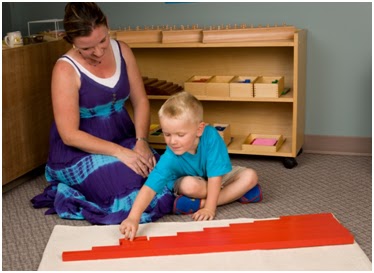
Becoming a Montessori teacher can seem overwhelming at times. There are so many lessons and activities to give, new materials to master, daily observations to record, getting used to a multi-age classroom, and learning to work with an assistant or co-teacher. When it comes down to it, the most important element is how you present lessons and interact with the children.
Here are some tips to remember when presenting Montessori lessons and activities:
Ten Important Things to Remember When Presenting Montessori Activities
Invite the child to participate.
As simple as this seems, there is a world of difference between being invited to work and being told to do it.Maintain eye contact when inviting or speaking to the child.
This respectfully tells the child that he has your undivided attention. In return, the child’s eyes tell you that the child is ready to learn.Show, not tell.
Use the fewest number of words possible during presentations. The child’s focus should be on the materials and the presentation, not on your words.Present from left to right, top to bottom.
All presentations move in this direction as an indirect preparation for reading and writing western script.
Sit on the child’s dominant side.
This way the child can watch and copy your exact movements. This might mean you need to learn how to present activities with your non-dominant hand!Use slow, deliberate movements.
Although you may have done this presentation 100 times, it is brand new to the child. Slow down so he can watch your exactness.Repetition increases success.
The child will not perform the activity with 100% accuracy the first time. Encourage them to use the materials repeatedly to increase their mastery.Use the three-period lesson: This is. Show me. Tell me.
Children need repeated exposure to new vocabulary to make it part of their repertoire. When presenting new vocabulary and concepts, use the three-period lesson to ensure that the child understands the term and can connect it successfully with its corresponding object.Stop and put it away.
If the child is not interested or is making mistakes, put the activity away. There will be another opportunity to present it later. Stop before you and the child become frustrated.Smile and Relax.
Watching children develop and learn is a joyful experience!Remember that there is more to being Montessori than having a classroom full of materials and child-size furniture. Take the time to make sure that you are fully in the moment for all presentations and interactions with children.
As much as possible, NAMC’s web blog reflects the Montessori curriculum as provided in its teacher training programs. We realize and respect that Montessori schools are unique and may vary their schedules and offerings in accordance with the needs of their individual communities. We hope that our readers will find our articles useful and inspiring as a contribution to the global Montessori community.
© North American Montessori Center - originally posted in its entirety at Montessori Teacher Training on Tuesday, July 23, 2013.
© North American Montessori Center - originally posted in its entirety at Montessori Teacher Training on Tuesday, July 23, 2013.

I really enjoy this blog!
ReplyDeleteMy favorite is "show, not tell". Very good advice - the focus shouldn't be on the teacher but on the activity.
Milena Tzaneva
Montessori teacher, Montreal
I really love this part:
ReplyDeleteUse the three-period lesson: This is. Show me. Tell me. this is really working so well. I did it to my class and I am amazed what they can do.
The best things about montessori is that you won't have a hard time in finding employment. And thank you for presenting the list of activities in your writing. Keep posting such good content.
ReplyDeleteAlways loved the articles here !! Thanks much
ReplyDeletethere is another important principle in Montessori which would be worth mentioning: don't correct the child by telling him what he did wrong. show him again the activity,so he can correct himself. at the same time use materials which can offer the control of error, so the child can work easier and find by himself the mistake.
ReplyDeleteWhy are the materials presented from left to right?
ReplyDelete